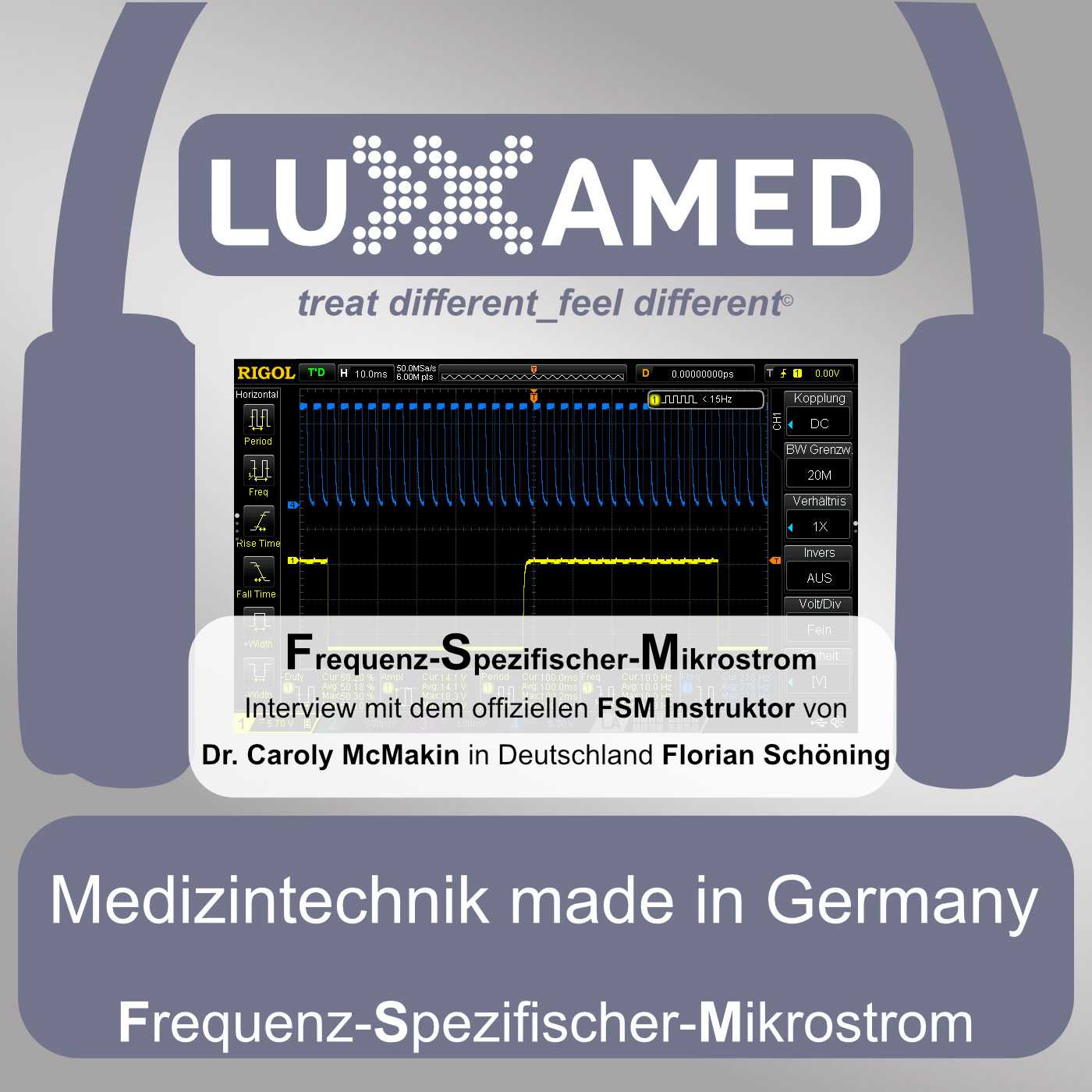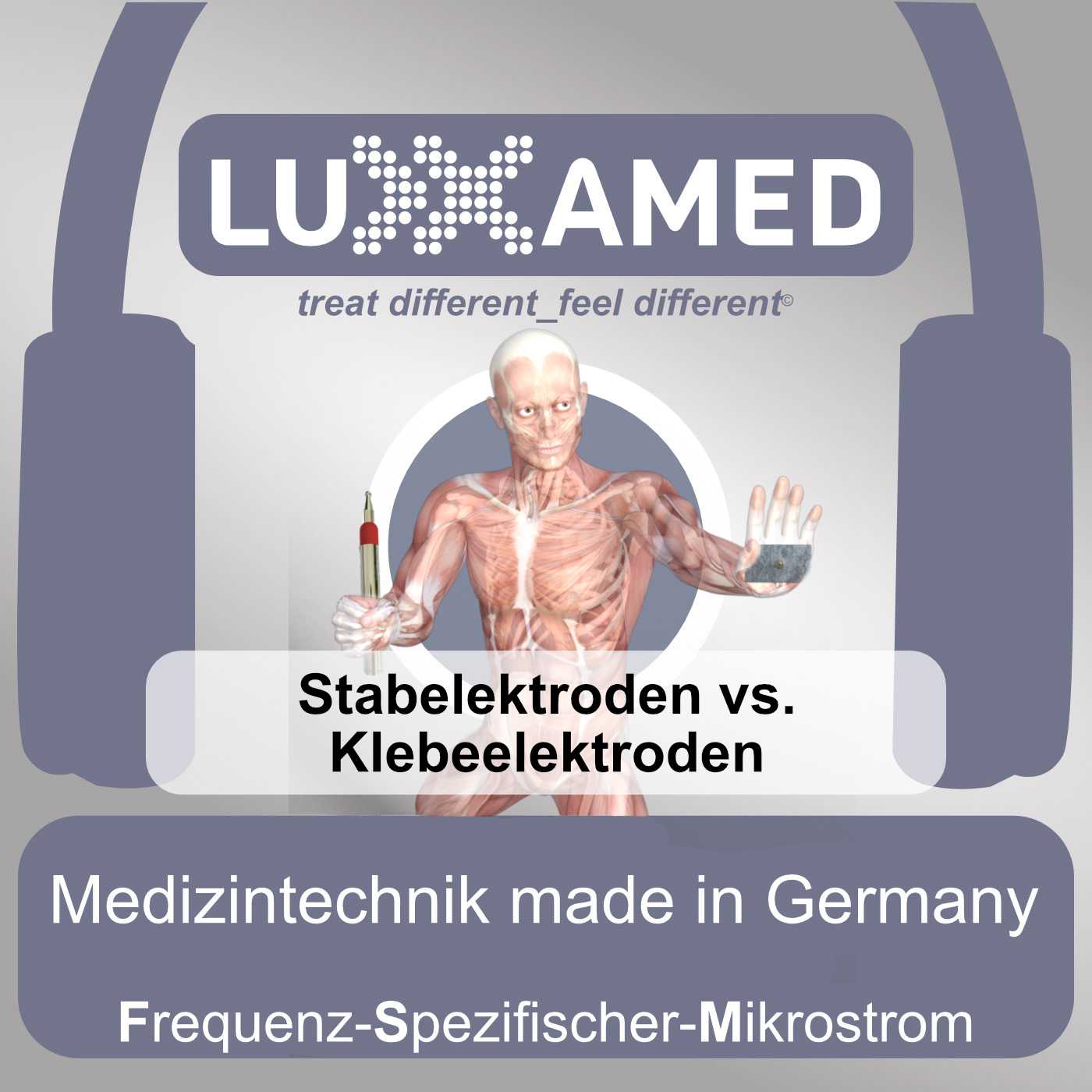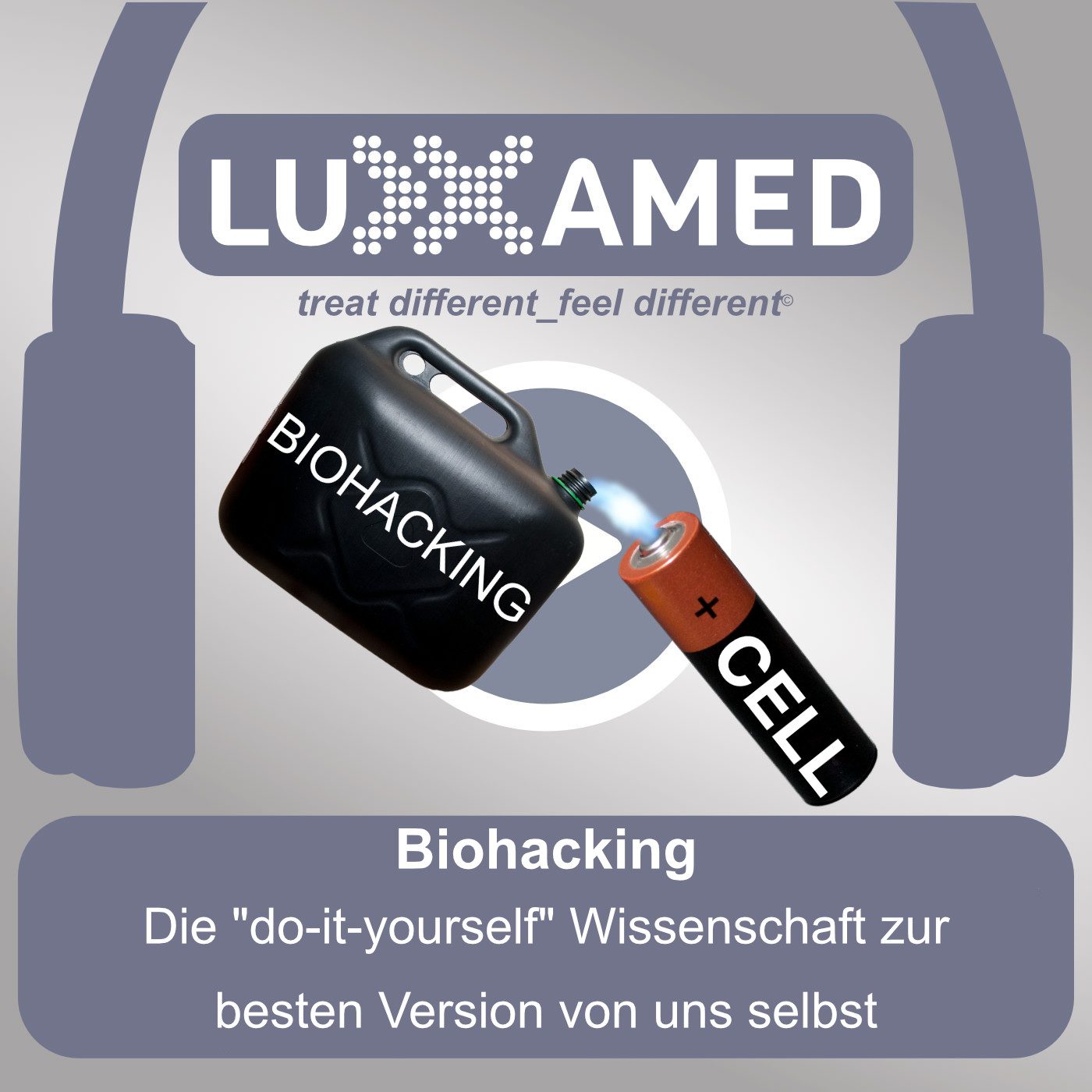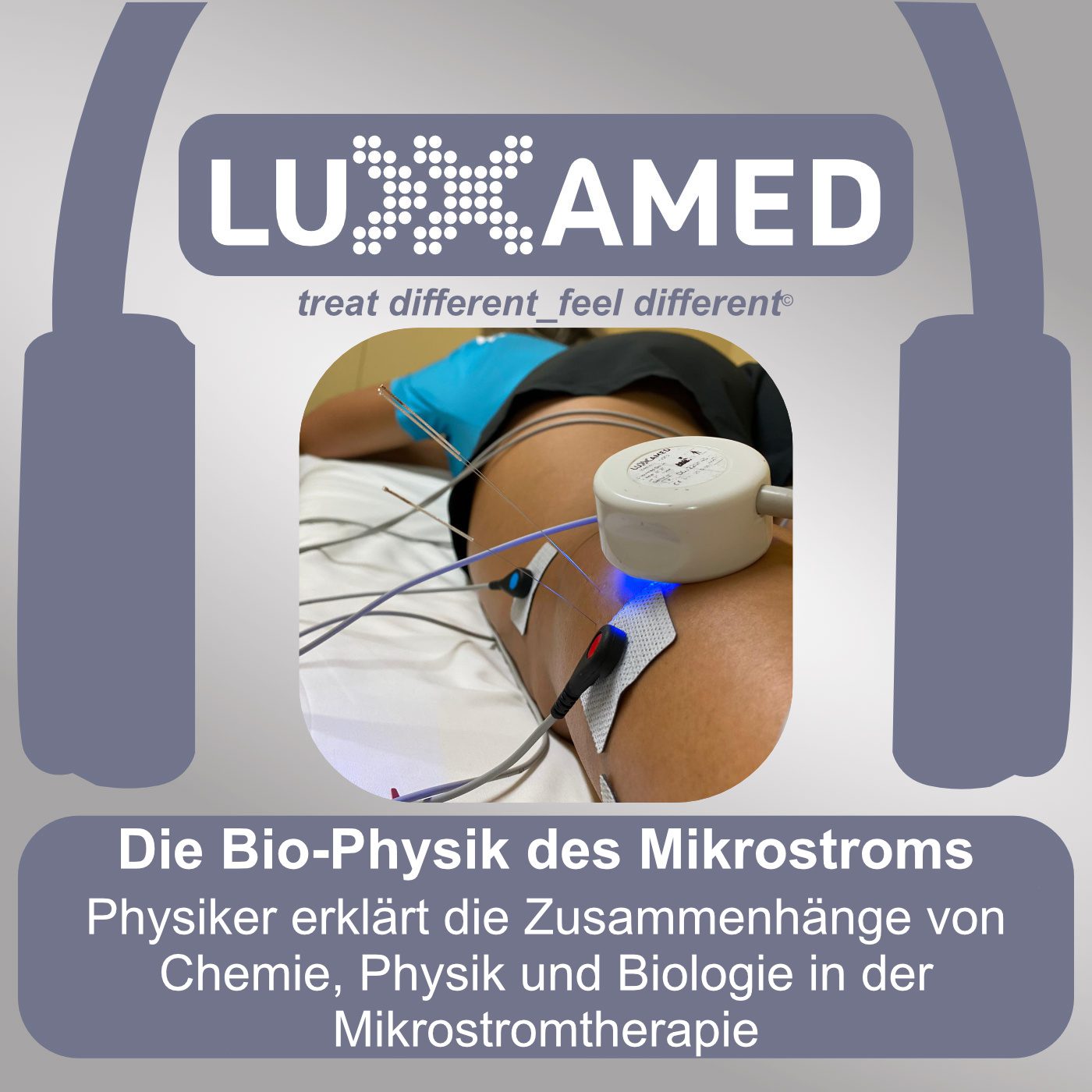Dieser Beitrag ist auch verfügbar auf:
![]() Deutsch
Deutsch
Microcurrent and the frequency
Questions about questions and is there actually a frequency-UNspecific microcurrent?
You are currently viewing a placeholder content from Default. To access the actual content, click the button below. Please note that doing so will share data with third-party providers.
The frequency in microcurrent therapy
Microcurrent, microcurrent therapy or frequency-specific microcurrent? And is there actual frequency-UNspecific microcurrent? Questions upon questions and what is actually all about this ATP production? Questions upon questions that we try to get to the bottom of a little in this episode.
The frequency is certainly one of the most legendary areas in microcurrent therapy. Studies and scientific works from all over the world show the effect around the correct and correct frequencies, but statements like: “Microcurrent is only frequency”; “When we talk about microcurrent, we are only talking about frequencies,” are a bit too short-sighted.
These statements are both right and wrong to the same extent. Viewed in isolation, focusing on frequency – in connection with microcurrent – is wrong! Microcurrent therapy is made up of various effective parameters:
- Voltage in volts (V),
- Amperage in ‘micro’ amperes (µA),
- Waveform and configuration of the signal (square wave signal),
- Polarity (+; -; +/-),
- Rise in signal,
- oh yes and the frequency in Hz.
The YouTube video with the corresponding images can be found at: https://youtu.be/McsFuBYrR_k
Literature sources:
CHENG, N., van HOOF, H., BOCKX, E., HOOGMARTENS, MJ, MULIER, JC, DIJCKER, FJ de et al. (1982). The Effects of Electric Currents on ATP Generation, Protein Synthesis, and Membrane Transport in Rat Skin. Clinical Orthopedics and Related Research, & NA; (171), 264-272. https://doi.org/10.1097/00003086-198211000-00045
Maybe also interesting?
https://www.luxxamed.de/2020/11/12/fsm-frequenz-spezifischer-mikrostrom/
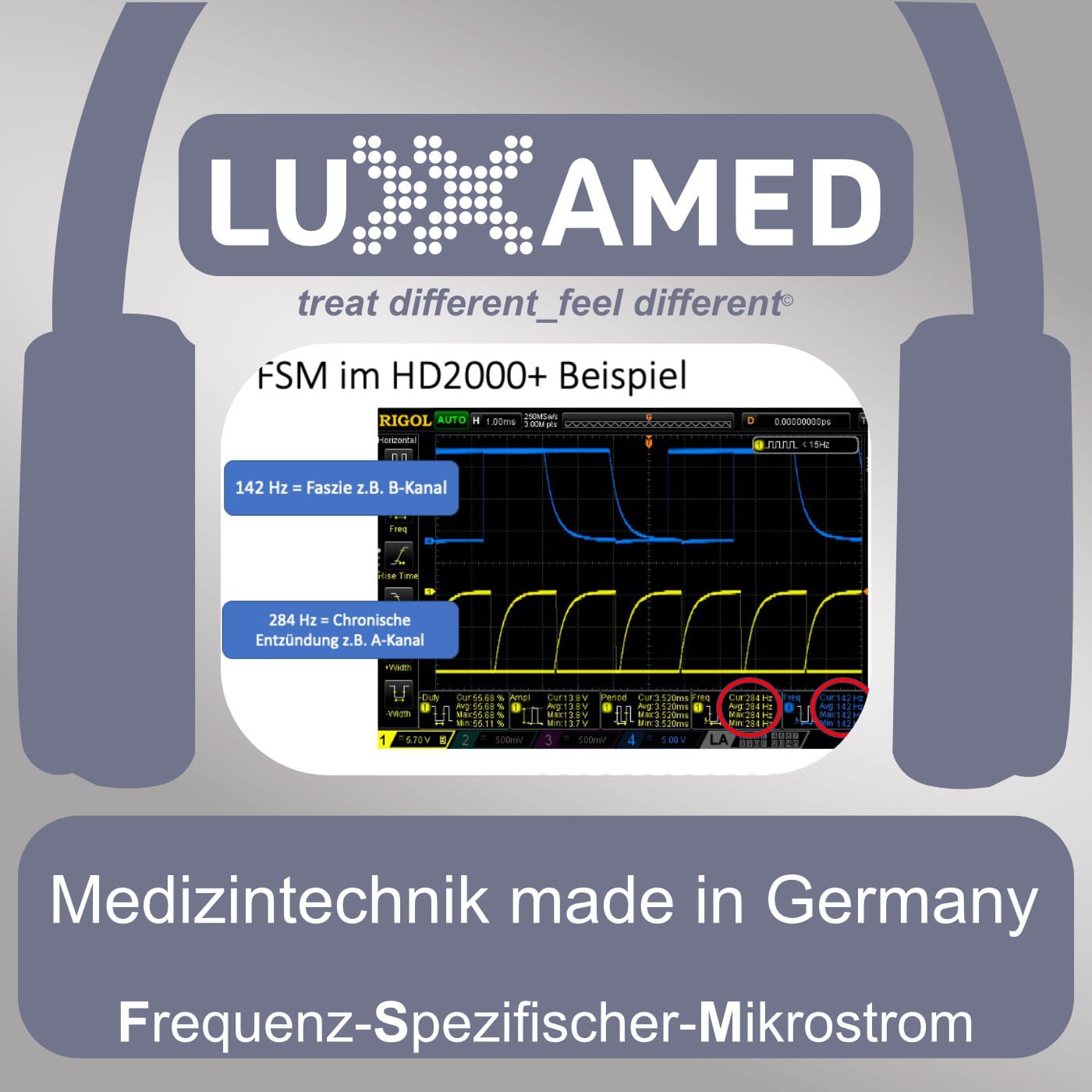
You are currently viewing a placeholder content from Default. To access the actual content, click the button below. Please note that doing so will share data with third-party providers.
Transcript of this episode: frequency and microcurrent
Literal – unadjusted – transcript of this episode
00:00:00
Speaker: Then I’ll say Moin and welcome! New podcast, new show. No, not a completely new show: We’re in it for a while. Welcome to the Luxxamed Podcast – the podcast on frequency-specific microcurrent. My name is Patrick Walitschek and this time I didn’t bring you an interview, but instead something different, sometimes a little solo of mine and indeed I was inspired: I published a YouTube video on the subject of ‘The frequency and the microcurrent – question after question. ‘ And this video went off relatively well – went viral, as the new German puts it – on YouTube. So I thought to myself, I can do a little podcast about this before we start again with the next interviews, so today I would like to talk a little about the topic of frequencies, i.e. frequencies in the sense of effective parameters for the microcurrent. And before we go into the topic of frequencies specifically, I would like to straighten the whole thing out a bit, because there are so many statements on the Internet, in social media, on various websites that I have seen on the subject of frequency-specific microcurrent: It will yes, completely separated from the field of microcurrent therapy. There is microcurrent therapy and there is frequency-specific microcurrent therapy. What is the difference and is there actually non-specific or non-frequency-specific microcurrent therapy? Yes, those are questions, I would like to go into them a little today, from a technical, biophysical and medical perspective. Before I go into detail on the topic of frequencies, I recently read in a group on Facebook that there was also the question of frequency-specific microcurrent devices, it always has to be frequency-specific, that is very important and it was also about the signal shape and the curve shape .
00:02:01
Speaker: So let’s just start now with the subject of the active parameters of the microcurrent with the curve shape. The question was or was asked: It always has to be a square-wave signal – a sine would not be effective there. So I can say about this from my personal experience – and with microcurrent it has been going back almost to the year 2000, i.e. over 20 years – I can say that I have not yet come across a microcurrent device that had a sine wave. I know that there are classic electrotherapy devices that can also be reduced in current strength to such an extent that they output microscurrent there, i.e. in the sense of microamps, also with other curve shapes, but classically. And let’s look into the literature by Dr. McMakin all the way through to Dr. Wing and others, we always work with a square wave signal, of course also with us and since 2000 we have been doing microcurrent therapy in Germany or Europe and far beyond, i.e. sales, production, schooling, courses and so on and always with a square wave signal. So let’s keep an eye on: We have an effective parameter, that is the square wave signal. Lets move on. We have another effective parameter, namely the current strength itself. Everyone always says “microcurrent, microcurrent, microcurrent – what exactly is microcurrent?” I mean, that is not a direct term technicus, so it is not clearly defined now, it has become commonplace in colloquial language, just like the speed of the handkerchief, has become commonplace that the microcurrent is a current with a strength of Microamps, i.e. millionths of an ampere range. One can now exaggerate the assertion that in principle this would be the strength of the current that can naturally also be measured in the body and that flows there accordingly. I mean, I’ve already done podcasts about it, also with physicists and doctors, where the point was to explain what actually happens in the cells, what happens around the cells, the membrane potential and so on, so I don’t want to elaborate on. This is about the effective parameters: The microcurrent itself is an effective parameter and I will explain in the following why this is totally important and why it is also important to adapt it, i.e. not to leave it at one current strength, but also to have a certain one all the time To give leeway. The next point is the voltage, measured in volts, the symbol here would be V. The voltage is also extremely important – I’ll go into it a little more specifically afterwards, but this is also important and should be taken into account in the therapy . It’s a conglomerate. And then of course we also have the polarity, i.e. the direction of current flow, which can change. There is always the question of what people are talking about: Are you talking about the physical direction of current flow, the technical direction of current flow? Yes, you can do your own episode about it, but the polarity is extremely important and we found that out: We carried out clinical studies that were published internationally, I would only recommend Krummenauer and so on. Last year, in 2020, we published a study on fibromyalgia patients in Italy and it was also published internationally by PubMed and here, too, we were able to clearly show that polarity is an extremely important fact in the context of microcurrent therapy. And finally, of course, the frequency: of course, the frequency is important. Of course, microcurrent is frequency-specific in our and my understanding, but it plays in all the parameters that I have just introduced, i.e. microamps, volts, polarity, curve shape, i.e. the so-called square wave signal, it plays like in an orchestra together with all the parameters decisive role. This is important to know and should definitely be taken into account.
00:06:09
Narrator: After all, if we talk a little about the current and the microampere, it is widely known that the current strength itself has an effect on the cell metabolism. In a laboratory experiment in 1982, Cheng demonstrated that currents of up to 500 microamps can increase ATP production, the membrane potential, i.e. membrane transport and protein synthesis. I would like to say again very clearly here that I will go back to a claim that I have read on social media and on various websites – which, by the way, is absolute nonsense, but good – 4.2 micromoles per gram to 2.1 Micromoles per gram were clearly demonstrated. This means that we have an increase of 4.9 times, this was demonstrated in 1982 by Cheng et al in a laboratory experiment, based on the ATP production. I myself accompanied a study at the Fraunhofer Institute and we just looked, how does the Luxxamed do it? Do we actually have a similar influence, comparatively similar influence as with Cheng and with other studies, both with our light therapy in isolation, viewed in isolation, and with the microcurrent on the cell metabolism? And yes, we could prove the whole thing. We have not looked by how many percent the ATP production increases. Except for the light, we actually looked at it, but with microcurrent we first looked at a basic study to see how we can get to the cells. These were human cell cultures that were examined there? So is the Luxxamed HD 2000 plus able to positively influence the cell metabolism, in the case of previously suggested cell cultures? And yes it is. So. But what we have seen in the past, and as I said, we are talking about 20 years of experience in the field, both with therapists and with doctors and non-medical practitioners, that an adjustment of the current strength in the range of 10 to 500 microamps is extremely important in many areas of IT. And that should d
00:08:11
Speaker: efinitive nic – that t have been neglected. Now I have, h auf agt, this claim that I have read. I have read social media, and on various Internet sites say how an ATP production or ATP increase of up to 800 percent is possible. So that’s just plain wrong. So by Cheng ha, you can do the Jeng publication, anyone can do it at PubMed and other relevant providers: It etern where studies are published, it is perfectly clear that what is wrong. So he has 4.9 times that. Well, you could say something like that, it’s 500 percent, but over 800 percent is definitely important. As
00:08:45
Speaker: Oh, I’ll only say Cheng 1982 for comparison Which I would also like to mention, because we are talking about frequencies and the frequency orchestra, where I will listen, which I would also like to mention. If we look at the ATP study and speak of ATP and frequency-specific microcurrent, then one should definitely keep in mind that Cheng did this with a direct current source at the time. In other words, he has a lot of amperage, has taken direct current – in the study you can see such a rudimentary circuit diagram of how he did it, with a new volt block, by the way – has the microcurrent, so to speak produced above it with different resistances and thus causes a 4.9-fold increase in ATP. Let’s take a look at the tension again. When it comes to tension, it is important that you do it yourself, i – principle, I sometimes explain it, when I talk to patients, when I talk to very mixed users, I say. Think of it like a garden hose. Yes. The microcurrent is, so to speak, the amount of water that we bring into the body, so to speak. Now call the electricity as water as an analogy and the voltage is then the pressure behind it. Of course, if we now have a high resistance and the resistance in the tissue, mind you, in the tissue, the tissue resistance is comparable to the diameter of the tube, we have a very small tube and would like the same amount of water through it in the same time Pumping, we of course not only need more pressure, i.e. more – voltage, because the voltage ensures, among other things, that we ionize the uppermost layers of skin so that the microcurrent with its frequencies also penetrate deeper tissue layers, thin. And there I have such a little quote. I have shown that a bit: The microcurrent influences the natural cell tension in the tissue and thus the extracellular matrix through a flow of electrons. Thus, it can be said that he is able to give each cell back its own potential. And the Zita. It’s not mine. That is from Fl 7. A book about it has also been published accordingly. It was about detoxification and drainage and, of course, cosmetic applications with microcurrent, which is where we did too
00:10:56
Sprecher: entsprechend Einsatzbereiche haben. Kommen wir aber jetzt zu dem entsprechenden Hauptteil dieses Podcast, nämlich zum Thema Frequenzen. Und die Frequenzen sind sicherlich der, ich nenne es jetzt mal, sagenumwobenste Teil, die sagenumwobenste Komponente im Zusammenhang mit der Mikrostromtherapie. Ich habe Aussagen gesehen, in Webinaren, in Fachvorträge, in Fortbildungen, die waren recht lustig. Unter anderem Aussagen wie zum Beispiel: “Mikrostrom ist nur Frequenz.”, “Die Frequenzen alleine machen die Wirkung.”, “Alles ist Schwingung und der Mikrostrom bringt über Zustands- und Gewebsfrequenzen alles ins Gleichgewicht.” All diese Aussagen sind teilweise richtig, aber auch zu gleichen Teilen ebenso falsch. Und zwar, wenn man sie solitär betrachtet. Denn Mikrostrom ist nicht nur Frequenz, wie ich das eben über die Wirkparameter dargestellt habe. Und ich könnte das und werde das vielleicht in Zukunft auch nochmal auf elektrotechnische und physikalischer, biophysikalischer Ebene ganz klar darlegen, weil wir eben auch mit dem Fraunhofer-Institut dazu Untersuchungen durchgeführt haben. Jetzt gibt es natürlich den Begriff der FSM, ‘the Frequency Specific Microcurrent’, also eine in den USA geprägte Therapieform, die auch wirklich super ist. Also ich sage nicht, dass Frequenzen – das möchte ich hier gleich vorweg sagen – ich sage nicht, dass das alles falsch ist und ich sage nicht, dass das nicht stimmt. Um Gottes Willen. Wir nutzen spezifische Frequenzen seit über 20 Jahren mit dem Klinikmaster angefangen, Klinikmaster MSG 1200, Klinikmaster Professional, Vitalmaster Luxxamed HD 1000, HD 2000, HD 3000, jetzt im HD 2000 + natürlich auch. Jetzt natürlich auch mit dem Zusatz, dass Sie, als Anwender, Therapeut, Arzt, Heilpraktiker in der Lage sind, frequenzspezifische Protokolle mit entsprechenden zeitlichen Abläufen selbst zu erstellen und die auch abzuspeichern. Also ich sage nicht, dass das alles nicht stimmt und ich habe den größten Respekt eben vor dem Bereich der Frequency Specific Microcurrent-Liga oder wie man das auch bezeichnen möchte. Und natürlich Frau Dr. Caroly McMakin, die ich persönlich mehrfach kennengelernt habe, sowohl in Deutschland als auch in England, in London genauer gesagt. Und was sie gemacht hat, was sie geleistet hat, ist natürlich eine Pionierarbeit gewesen, auch im Sinne der Wissenschaft. Also wir sind ja oder ich persönlich bin auch sehr, sehr stark wissenschaftlich geprägt, auch über entsprechend meine Ausbildung, mein Studium. Und, dass es natürlich darum geht, immer Dinge kritisch, wissenschaftlich zu hinter leuchten und was ich gesehen habe und die ganzen Veröffentlichungen die sie gemacht hat, sind super, also ich möchte hier nichts schlechtreden und nichts in Abrede stellen, um Gottes willen, im Gegenteil. Aber ich möchte ganz einfach diese Aussagen, die halt von Anwendern oder auch von jemandem, der sich damit vielleicht nicht so auskennt immer kommen, dass alles nur Frequenz ist, möchte ich mal so ein bisschen darstellen, denn das ist halt einfach falsch. Und FSM ist – wie gesagt – in den USA durchaus ein großes Thema, also Frequency Specific Microcurrent, die frequenzspezifische Mikrostromtherapie und ich habe mir überlegt, wie kann man jetzt eine Analogie schaffen? Ich mag sehr gerne Analogien und versuche das mit einfachen Worten zu erklären. Und ich habe mir mal ausgedacht, die Frequenzen – in Hertz gemessen, also von Formelzeichen Hz – im Orchester der Wirkparameter sind die Töne, aber ohne Dirigent, Akustik des Raumes und Instrumente können diese nur bedingt wirken beziehungsweise das volle Potential kann einfach nicht ausgeschöpft werden. Und so, glaube ich, darf man das verstehen, jetzt mal weg von der Technik und weg von der Wissenschaft in einer Analogie betrachtet: Wir brauchen natürlich die Töne, im Sinne der Frequenz. Wir brauchen den Dirigenten, wir brauchen die Akustik, wir brauchen die Instrumente, um eben das gesamte Potenzial auszuschöpfen und daher sage ich ganz einfach, dass Aussagen wie “Mikrostrom ist nur Frequenz”, eigentlich schon von sich aus falsch sind. Schaut man sich die Studien an, die nicht über FSM sind, sondern über Mikrostrom allgemein, und hält sie einfach gegen die FSM – also mit gegen meine ich ergänzend dazu – dann sieht man ganz einfach, dass der Mikrostrom, dass die Spannung, die Polarität, die Kurvenform auch ein entsprechenden Inpact auf die Wirkung einer Therapie haben. Vielleicht nochmal so ein bisschen rein in das Thema, mal ganz kurz mit einem Satz: Was sind eigentlich Frequenzen? Wir sprechen immer Frequenz, Frequenz, Frequenz: Was ist eigentlich eine Frequenz? Und schaut man mal bei Wikipedia, so sagt Wikipedia: “Die Frequenz ist in der Physik und Technik ein Maß dafür, wie schnell bei einem periodischen Vorgang die Wiederholungen aufeinander folgen, zum Beispiel bei einer fortlaufenden Schwingung.”. Also das ist eine Frequenz, also man gibt eine Periode vor und sagt, ich möchte verschiedene Wiederholungen dort hineinpacken. Klassischerweise ist die Periode in der Mikrostromtherapie 2,5 Sekunden lang und dort werden eben entsprechende Frequenzen draufgelegt. Und jetzt natürlich die Frage, die stelle ich jetzt mal in den Raum: Gibt es eigentlich eine frequenzunspezifische Mikrostromtherapie, nachdem was ich jetzt erzählt habe? Nein, gibt es natürlich nicht! Wäre eine Mikrostromtherapie unspezifisch, dann wäre es ja quasi eine galvanische Gleichstromtherapie, wenn man das mal ganz klassisch betrachtet. Und übrigens möchte ich vielleicht in diesem Zusammenhang nochmal was zum Frequenzbereich sagen – da wird ja auch immer viel diskutiert. Ich meine, schauen wir uns die Literatur an und wir haben ja bei Frequenzen weit hinaus noch über FSM, klassisch US FSM, nenne ich es jetzt mal, hinaus noch weitere Frequenz-Anbieter – kann man auch so nennen – wie beispielsweise Rive, wie Klag und so weiter. Da gibt es Frequenzen, die kann man durchaus im Mikrostrombereich einsetzen und umsetzen, aber klassischerweise bewegen wir uns im niederfrequenten Bereich – niederfrequent im Sinne des Mikrostroms. Im Sinne des Mikrostroms, würde ich sagen, liegen wir bei bis 1.000 Hertz: Das ist der klassische Bereich. Wir bei Luxxamed gehen da ein bisschen weiter, weil wir noch weitere Bereiche abdecken wollen, auch im Rahmen der entsprechenden Therapiekybernetik, also diese Automatik und dieser Scanvorgang zur Parametisierung des Gerätes, um Frequenzparameter auch abscannen zu können. Wir gehen da bis 20.000 Hertz, um auch noch weitere Wirkparameter, beispielsweise aus Rive und so weiter, mit aufnehmen zu können. Aber zurück, zum Unterstreichen der Aussage: “Gibt es frequenzunspezifische Mikrostromtherapie?'” Nein, dann wäre es galvanische Gleichstrom. Das ganz kurz eben zu diesem Thema. Gehen wir weiter im Text und schauen uns mal an, was ist sozusagen jetzt das Thema frequenzspezifischer Mikrostrom im Bereich HD 2000 +. Ich hatte es gesagt, man hat jetzt die Möglichkeit, das ganz klassisch, wie es in den USA auch gemacht wird, im HD 2000 + durchzuführen, also jeder kann hergehen und kann auf vier unterschiedlichen Kanälen – wir reden hier über galvanisch getrennte Kanäle – entsprechend seine Gewebs- und seine Zustandsfrequenz eingeben und kann sich seine eigenen Frequenzprotokolle dort zusammenbauen oder die vorhandenen Frequenzprotokolle nutzen. Ein Klassiker – ich will nur mal ein Beispiel geben, dass man sich das vorstellen kann: Bei YouTube hab ich ein Video gezeigt – ich werde übrigens den Link zu YouTube hier in den Shownotes mit veröffentlichen, weil ich da ein Bild einer Live-Messung vom HD 2000 + zur FSM dargestellt, so dass man mal ein Auge hat dafür: Was ist denn eigentlich eine Frequenz? Wie sieht das technisch aus? Ich habe hier mal ein Beispiel gebracht, 142 Hertz – das ist die Muskelfaszie – auf dem B-Kanal oder auf dem zweiten Kanal und die 284 Hertz, das ist die chronische Entzündung aus der Literatur hinaus von Dr. Carol McMakin – auf dem A-Kanal. So wird es entsprechend kombiniert, also der Zustand und die Frequenz auf erstmal zwei Kanälen. Jetzt kann man natürlich, wenn man mehrere Kanäle hat, verschiedene Dinge gleichzeitig tun: Man kann die Frequenzen entweder doppeln, man kann sagen “Ich möchte verschiedene Bereiche gleichzeitig behandeln”, eben über galvanisch getrennte Kanäle. Vielleicht ganz kurz zur Erklärung, was das bedeutet: Wir wissen, jeder Kanal hat zwei Pole, hat eine Anode und eine Kathode und man möchte natürlich sicherstellen, dass der Stromfluss nur zwischen eben entsprechend dem einen Kanal stattfindet und so wird das über einen technischen Trick, nenne ich ihn einmal, also diese galvanische Trennung sichergestellt, damit halt keine Interferenzen auftreten zwischen den Kanälen, weil dann die FSM auch gar nicht funktionieren würde, weil wir wollen ja nicht, dass beispielsweise sich Frequenzen gegeneinander addieren oder subtrahieren, also eine positive oder negative Interferenz darstellen. Daher muss das Ganze natürlich galvanisch getrennt sein. Und wie gesagt, in dem YouTube-Video sehen Sie ein Live-Bild von einem Oszillogramm, was ich dort aufgezeichnet habe und mit eingestellt habe. Was ist jetzt aber das Spezifische, gerade wenn wir über den Luxxamed sprechen, die HD 2000 + sprechen, denn wir haben nicht nur die Frequenzen, die seit Jahren in der Frequency Specific Microcurrent-Ära eingesetzt werden, sondern wir haben natürlich auch selbst praxiserprobte FSM-Protokolle und eben das gesamte Orchester mit implementiert. Deswegen sage ich, das ist so wichtig, nicht nur isoliert auf die Frequenz zu schauen: Die Stromstärke ist wichtig und die Stromstärke ist natürlich… Jeder kennt noch aus dem Physikunterricht das ohmsche Gesetz abhängig von Spannung und/oder Widerstand. Also das sind alles Faktoren und die haben wir natürlich über die jahrzehntelange Arbeit – also wir haben im Jahr 2009 bereits angefangen mit der Entwicklung dieser kybernetischen Parametrisierung des Gewebes, mit den letzten Klinikmastermodellen, mit Prototypen, um zu schauen, wie können wir das Ganze messen und wir können wir dem Widerstandswert auch in Korrelation zur Frequenz setzen, aber auch zu den anderen Parametern wie Spannung, Stromstärke und Polarität, und das haben wir halt eben kombiniert in diesen Automatikprotokollen und die sind natürlich frequentspezifisch. Für alle, die eben eigene Protokolle erstellen wollen – kein Problem: Die kann man einstellen, die kann man abspeichern für jeden Kanal und man kann sich sogar seine Messung dazu anzeigen lassen und das ganze auch durchscannen lassen. Man kann seine eigenen Frequenzprotokolle einmal durch den Scanner jagen und schauen: ‘Okay, wo verändert sich jetzt der Gewebswiderstand, der auch einen eklatanten Einfluss eben auf den klinischen Zustand im Gewebe haben kann?’, also so haben wir es eben in unseren Erfahrungen von unseren Kunden und in den Studien gesehen. Das war es einmal so grob zum Thema Frequenzen. Weil, das war mir wichtig, das einmal ganz kurz zu erklären: Es ist nicht nur alles Frequenz, es schwingt zwar alles – auch der Schreibtisch, an dem ich hier sitze, hat ja in dieser Theorien, in dieser Hypothese, eine Schwingung. Das mag alles richtig sein, aber solitär betrachtet funktioniert die Schwingung des Schreibtisches nicht ohne die Masse dazu und ohne die entsprechende Dichte, weil sonst würde alles, was hier drauf liegt, runterfallen. Und daher darf man das Ganze eben nicht solitär betrachten, sondern möchte das Ganze auch mal als Gemeinschaft betrachten, eben wie ein Orchester. Und damit zurück zum Mikrostrom: Ich spreche hier sehr, sehr gerne über eine Frequenzorchester, wo halt viele Parameter entsprechend enthalten und entscheidend und wichtig sind. Das einmal so ganz kurz dazu. Wie gesagt, alle Links, die ich erwähnt habe, hauptsächlich war es der YouTube-Link dazu. Ich werde aber auch noch einmal ein paar Links in die Shownotes packen zu den Studien, die wir durchgeführt haben – das kann ja auch für den einen oder die andere interessant sein, sich das mal eben aus wissenschaftlich medizinischer Ebene auch ein wenig anzuschauen. In dem Sinne wieder der klassische Spruch am Ende aller der Podcast: Abonnieren Sie unseren Podcast, egal wo Sie uns hören. Sei es bei Spotify, sei es bei Apple Podcast, sei es bei Google Podcast, bei Apple Music, wo wir jetzt auch neuerdings vertreten sind oder wie auch immer – in welchem Portal Sie uns auch hören, abonnieren Sie uns. Haben Sie Fragen, einfach schreiben. Sie finden alle Kontaktinformationen auf www. Luxxamed – mit Doppel x – Luxxamed, ein Wort, .de: Dort finden Sie unter Kontakt alle Kontaktdaten, finden Sie auch unser Kundenforum im geschützten Bereich, die Videotrainings mit derzeit über 19 Stunden Schulungs- und Videotrainingsmaterial, wo stetig neue Inhalte auch hinzukommen. Also in dem Sinne: Anregungen, Kritik, Wünsche, haben Sie etwas zu erzählen zum Thema Mikrostrom in einem Interview? Das wäre toll. Melden Sie sich: Machen wir gerne eine kleine Podcastshow. Übrigens geht es auch mittlerweile per Telefon, wir können es per Zoom, per Skype – das Medium ist vollkommen egal – durchziehen. Jetzt aber in dem Sinne: Ganz herzlichen Dank fürs Einschalten. Vielleicht erwartet Sie in der nächsten Woche oder in der nächsten Zeit – wir haben ja den wöchentlichen Rhythmus etwas verlassen, das hatte ich ja auch angekündigt Anfang diesen Jahres, weil viele Projekte dieses Jahr anstehen: Die MDR, die Medizinprodukteverordnung kommt dieses Jahr. Nun – ich sage persönlich nun endlich – viele schimpfen darüber. Auch große Firmen schimpfen da drauf und haben mehr oder weniger Angst davor. Ich freue mich drauf, weil sich dann viele auch mal ein bisschen ins Zeug legen müssen, in dem Sinne, aber dazu werde ich vielleicht auch noch einmal eine Episode bringen – ich glaube, das ist ganz, ganz spannend. Aber jetzt endlich: Vielen Dank fürs Einschalten. Bleiben Sie uns treu. Bis zum nächsten Mal, vielleicht mit einem Interview, vielleicht auch nicht. Aber bis dahin alles Gute. Bleiben Sie gesund! Tschüss.

